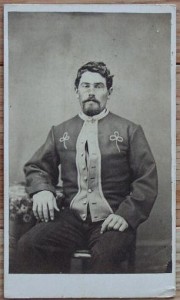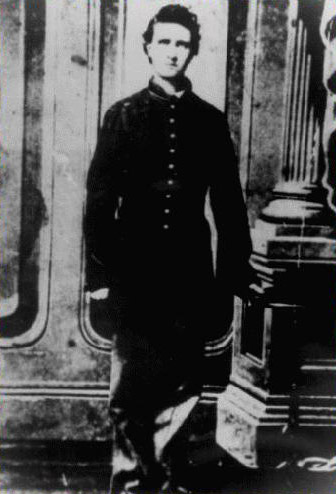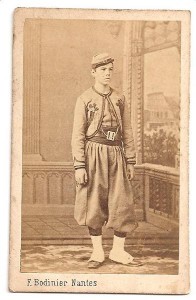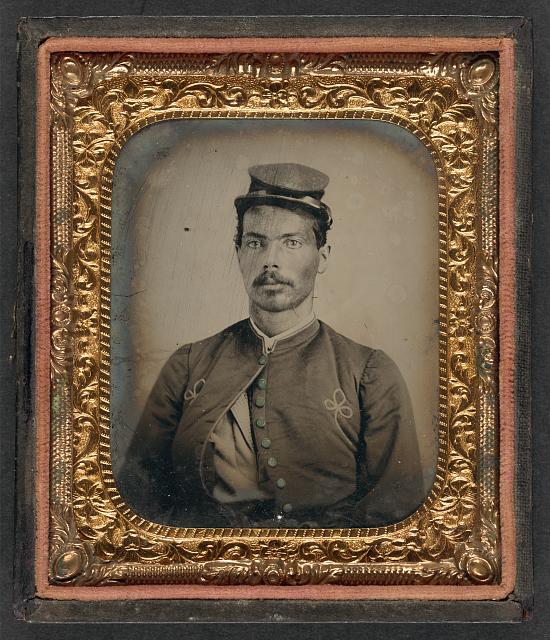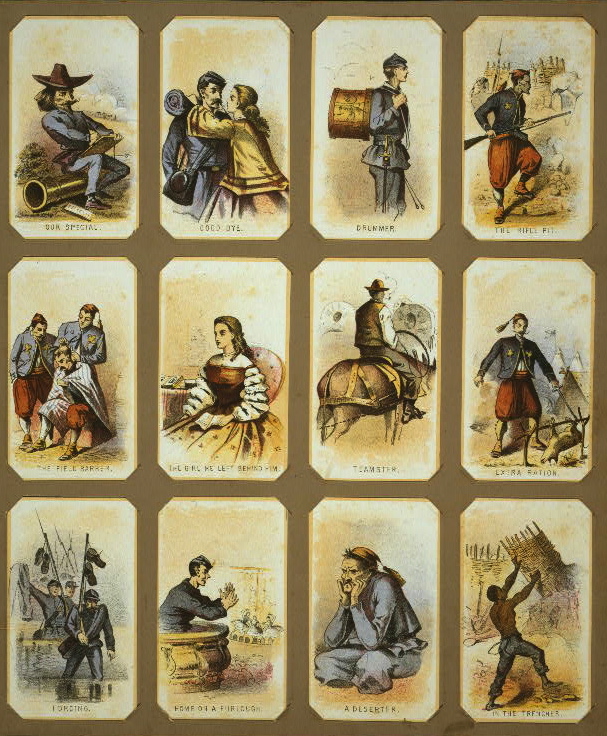Okay – I know this isn’t the prompt for this week, but I spent too much time on it to just let it sit here. If I find the time, I’ll work on the one I’m supposed to do for this week. 🙂
The Sepia Saturday prompt for Oct. 13th brought to mind a photograph of my paternal 2nd great-grandfather, John Sylvester Strange. I had a terrible time pulling the post together, and finally went with something completely different. I was making it too hard. Allow me to begin again….
John Sylvester Strange served in Company K of the 49th Indiana Infantry during the Civil War. The unit mustered in on November 21, 1861 and mustered out on November 28, 1864. As an infantry unit, they traveled 8,000 miles during those three years.
But this post is not about the details of John Sylvester Strange’s military service. This post is about his uniform.
One of my cousins has this picture hanging in her home (hopefully a better copy). A painter, working in her home, took an interest in it because he is a Civil War re-enactor. He thought the unusual design on the jacket indicated that J. S. Strange was a musician. We had heard that our ancestor was a chaplain, but never that he was a musician.
I scoured lots of Civil War images online and finally found a clue on a website (now inactive) about the 12th Indiana Regiment.
The unidentified man pictured left had the same trefoil design on his uniform jacket. The picture was listed under the heading “2nd Issue, or Zouave uniform“.
“Manufactured by tailor Jacob Staub, on [sic] Indianapolis, Indiana and purchased by the men of the 12th IN in December 1863. They wore their veteran zouave jackets with their false-vests for the duration of their enlistments. Officers and enlisted men both wore the zouave jackets. Officer’s jackets had 3 small brass buttons on the cuffs Some men wore dark blue trowsers with their jackets, but this is a large minority of the regiment. The men wore plan [sic] forage caps with the uniform, as per a standing order from their Brigade commander.”
The 1st Issue, or Regulation Uniform, it continued, “was issued by the Federal government and consisted of the Army-issued sack coat or frock-coat and a forage hat.”
In the picture on the right, J. S. Strange is wearing his Regulation Uniform frock coat. Before muster, many men had studio pictures taken in their uniforms. It is interesting to me that J. S. Strange was not photographed with any of the accoutrements of a soldier. No hat, no gun – just the coat and pants.
Rather than indicating status as a musician, J. S. Stange’s jacket in the first photograph was part of a Zouave uniform. The soldier pictured at left is wearing the uniform of a musician and carrying a musician’s sword (and forage cap).
So what is a Zouave? And why were North American Civil War soldiers wearing Zouave uniforms?
The New York 5th Infantry is one of the more famous Zouave units. As explained on their website: “The Zouave movement began in Algiers, North Africa, which French forces captured in 1830. Indigenous troops from the Zouaoua tribe who offered to serve in the occupying army were accepted into two battalions under French officers in order to protect the city and maintain peace. By 1831, King Louis Philippe of France sanctioned the use of these special Algerian Arab regiments which became known as Zouaves. The
French Zouave corps adopted the military tactics and non-western clothing of the North African troops which featured baggy trousers, short open jackets and Arab headgear – the dress of the local Turkish and African population. The ranks filled quickly with soldiers who were attracted to the adventurous life of the Zouaves, their unique esprit de corps which bound them together like a family, and relative freedom compared to the garrison life in France.”
“Of all the Civil War soldiers, the ZOUAVES (zoo’-ahvs) stand out as the most colorful and distinctive. The picturesque stye of the Zouave soldiers’ dress, their unique drill tactics and fearless demeanor in battle earned the original French Zouaves and their American counterparts the reputation of being 19th-century models of dashing gallantry and military discipline.”
Some Civil War units drilled and practiced quick-step marching and other Zouave tactics. Others simply adopted the uniform style.
If you are interested in learning more about the Zouaves or Civil War uniforms, you might take a look here, here, here, here, or here.
Quick step on over to the Sepia Saturday blog and see what’s in store today.



